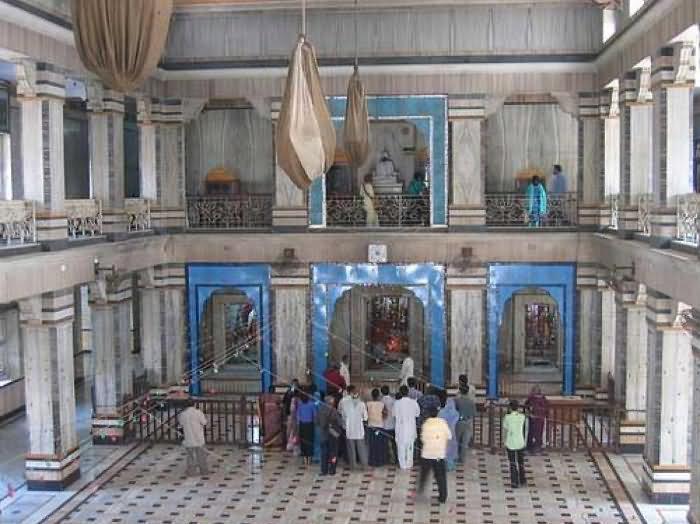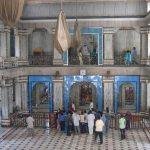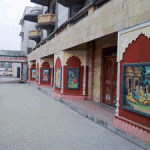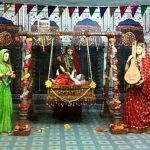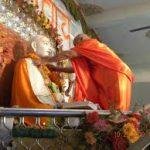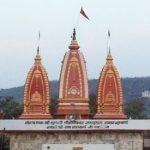Tulsi Peeth, Chitrakoot, Madhya Pradesh
| Date built: | 1987 |
|---|---|
| Deity: | – |
| Architectural style: | – |
| Major festivals | – |
| Locale: |
Chitrakoot, Madhya Pradesh, India
|
| District:: | Chitrakoot |
| Address: | Aamodavana, Post Naya Gaon, Satna, SH 11, Chitrakoot, Madhya Pradesh 485331 |
| Phone | 07670265478 |
Tulsi Peeth Seva Nyas (Hindi: तुलसी पीठ सेवा न्यास, ISO Transliteration, IPA: [Tulasī Pīṭha Sevā Nyāsa] literally Service trust at the seat of Tulsi) is an Indian religious and social service institution based at Janki Kund, Chitrakoot, Madhya Pradesh. It was established by the Hindu religious leader Jagadguru Rambhadracharya on August 2, 1987.Rambhadracharya believes that this Peeth is situated at the place where the Hindu god Rama gave his sandals to his brother Bharat.
The Tulsi Peeth premises house the residence of Rambhadracharya, a temple known as Kanch Mandir with an attached hall called Raghav Satsang Bhavan, a small cow-pen, a school for visually disabled students, a temple known as the Manas Mandir which has the entire Ramcharitmanas engraved on its inside walls, and an exhibition of moving models from 16 scenes of Ramcharitmanas.There is also a hostel for students of Jagadguru Rambhadracharya Handicapped University (JRHU).
The activities of the Tulsi Peeth include study and propagation of Hindu religious texts in Sanskrit and Hindi, service of cows and Sadhus, publication of a monthly magazine, and organization of camps providing aids to for persons with disability.The institution has published various books authored by Rambhadracharya.
Architecture
In 1983, Rambhadracharya (then known as Rambhadradas) undertook his second six-month Payovrata, taking a diet of only milk and fruits and speaking only Sanskrit, at the Sphatik Shila in Chitrakoot. The Yuvraj of Chitrakoot, Hemraj Singh Chaturvedi, was impressed by Rambhadracharya and donated a 60 feet by 80 feet land area situated besides the Mandakini river at Janki Kund to Rambhadradas.Gita Devi, Rambhadradas’s elder sister, persuaded him to get an Ashram built on this plot. Rambhadradas got four rooms constructed there and started visiting the place frequently. He undertook a nine-month Payovrata at this newly built Ashram in 1986. He also started performing his Kathas there.Ramcharandas Phalahari, the Sampradaya Guru of Rambhadradas, wanted Rambhadradas to stay with him at his Ashram in Prayag, but Rambhadradas was reluctant. In 1988, Umacharan Gupta, a businessman from Manikpur offered to build a bigger Ashram and a temple on the condition that Rambhadradas stay there permanently. Rambhadradas agreed and the construction started. On 11 March 1987, the Kanch Mandir (literally glass-temple) was opened and Rambhadradas started living permanently in Chitrakoot. Following this, on the occasion of Tulsi Jayanti on August 2, 1987, he established Tulsi Peeth at the site of the Ashram. As the founder of the seat of Tulsi, the title of Śrīcitrakūṭatulasīpīṭhādhīśvara (literally The Lord of the Tulsi Peeth at Chitrakoot) was bestowed upon Rambhadracharya by Sadhus and intellectuals.Rambhadracharya believes that this Peeth is situated at the place where, according to the epic Ramayana, the Hindu god Rama gave his sandals to his brother Bharat.
Legend / Local stories
Photo Gallery
How to Reach:
Contact Details
Official Address

